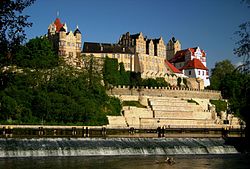Bernburg
Bernburg | |
|---|---|
 Bernburg Castle on the Saale river | |
Location of Bernburg within Salzlandkreis district  | |
| Country | Germany |
| State | Saxony-Anhalt |
| District | Salzlandkreis |
| Subdivisions | 7 |
| Government | |
| • Mayor | Henry Schütze (Ind.) |
| Area | |
| • Total | 113.45 km2 (43.80 sq mi) |
| Elevation | 85 m (279 ft) |
| Population (2022-12-31)[1] | |
| • Total | 32,261 |
| • Density | 280/km2 (740/sq mi) |
| Time zone | UTC+01:00 (CET) |
| • Summer (DST) | UTC+02:00 (CEST) |
| Postal codes | 06406 |
| Dialling codes | 03471, 034692 |
| Vehicle registration | SLK, ASL, BBG, SBK, SFT |
| Website | www.bernburg.de |
Bernburg (Saale) is a town in Saxony-Anhalt, Germany, capital of the Salzlandkreis district. The former residence of the Anhalt-Bernburg princes is known for its Renaissance castle.
Geography
The town centre is situated in the fertile Magdeburg Börde lowland on the Saale river, approx. 40 km (25 mi) downstream from Halle and 45 km (28 mi) up stream from Magdeburg. It is dominated by huge Bernburg Castle featuring a museum as well as a popular, recently updated bear pit in its moat.
The municipal area comprises the villages of Baalberge, Biendorf, Gröna, Peißen, Poley, Preußlitz, and Wohlsdorf, all incorporated on 1 January 2010.
Bernburg is a stop on the scenic Romanesque Road (Strasse der Romanik).
History
Several archaeological sites in the area refer to the Walternienburg-Bernburg Culture, a mid-neolithic funnelbeaker culture from about 3200 to 2800 BC. Agriculture on the fertile Loess soil was already common in prehistoric times. Around 150 AD, a local settlement named Luppia was mentioned in the Geography by Ptolemy. In the Early Middle Ages, the Saale river marked the border between the German stem duchies in the west and the lands of the Polabian Slavs in the east.
The present-day borough of Waldau (which became part of Bernburg in 1871) was first mentioned in a 782 deed and again in 806 as Waladala in the chronicles of Moissac Abbey; the village church dedicated to St Stephen first appeared in 964, the nowadays building dates from around 1150. Bernburg itself was first mentioned as civitas Brandanburg in a 961 deed issued by King Otto I of Germany. According to the Annalista Saxo, Berneburch Castle, then a possession of the Ascanian prince Albert the Bear, was set on fire by his enemies in 1138. In 1252 the rebuilt castle became the residence of Albert's great-grandson Prince Bernhard I of Anhalt-Bernburg in 1252.
Bernburg memorial
In the Nazi era during World War II, a wing of the town's mental hospital was used for the so-called T-4 Euthanasia Programme. The site today houses a memorial to commemorate the suffering of more than 14,000 victims.
International relations
Bernburg is twinned with:
 Anderson, Indiana, USA, since 1994
Anderson, Indiana, USA, since 1994 Fourmies, France, since 1967
Fourmies, France, since 1967 Rheine, Germany, since 1990
Rheine, Germany, since 1990 Tarnowskie Góry, Poland
Tarnowskie Góry, Poland Chomutov, Czech Republic
Chomutov, Czech Republic Trakai, Lithuania
Trakai, Lithuania
See also
References
- ^ "Bevölkerung der Gemeinden – Stand: 31. Dezember 2022" (PDF) (in German). Statistisches Landesamt Sachsen-Anhalt. June 2023.

